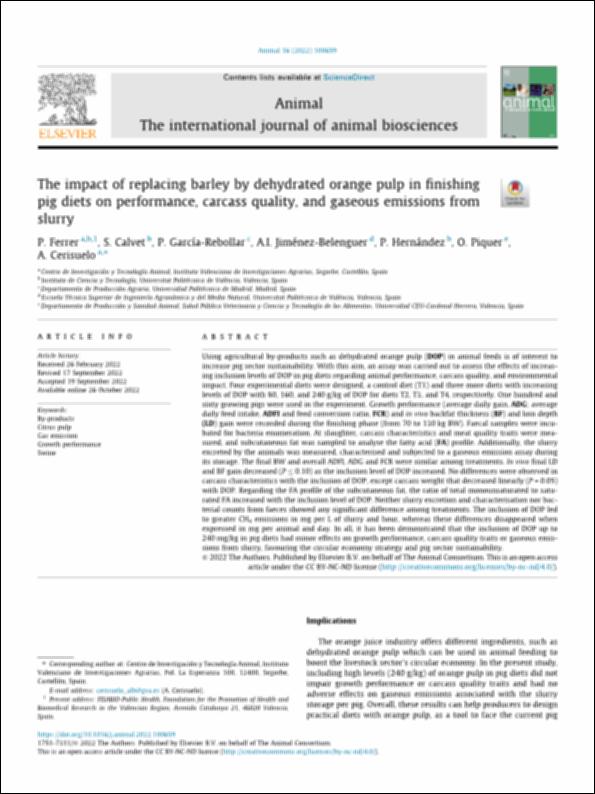Please use this identifier to cite or link to this item:
http://hdl.handle.net/10637/14306The impact of replacing barley by dehydrated orange pulp in finishing pig diets on performance, carcass quality, and gaseous emissions from slurry
| Title: | The impact of replacing barley by dehydrated orange pulp in finishing pig diets on performance, carcass quality, and gaseous emissions from slurry |
| Authors : | Ferrer, P. Calvet Sanz, Salvador García Rebollar, Paloma Jiménez Belenguer, Ana Isabel Hernández, P. Piquer Querol, Olga Cerisuelo García, Alba |
| Keywords: | Swine - Feeding and feeds.; Swine - Effect of pollution on.; Cerdos - Efectos de la contaminación.; Animal nutrition.; Cerdos - Cría y explotación.; Swine - Breeding.; Nutrición animal.; Cerdos - Alimentación. |
| Publisher: | Elsevier |
| Citation: | Ferrer, P., Calvet, S., García-Rebollar, P., Jiménez-Belenguer, A. I., Hernández, P., Piquer, O. & Cerisuelo, A. (2022). The impact of replacing barley by dehydrated orange pulp in finishing pig diets on performance, carcass quality, and gaseous emissions from slurry. Animal, vol. 16, i. 11 (nov.), art. 100659. DOI: https://doi.org/10.1016/j.animal.2022.100659 |
| Abstract: | Using agricultural by-products such as dehydrated orange pulp (DOP) in animal feeds is of interest to increase pig sector sustainability. With this aim, an assay was carried out to assess the effects of increasing inclusion levels of DOP in pig diets regarding animal performance, carcass quality, and environmental impact. Four experimental diets were designed, a control diet (T1) and three more diets with increasing levels of DOP with 80, 160, and 240 g/kg of DOP for diets T2, T3, and T4, respectively. One hundred and sixty growing pigs were used in the experiment. Growth performance (average daily gain, ADG; average daily feed intake, ADFI and feed conversion ratio, FCR) and in vivo backfat thickness (BF) and loin depth (LD) gain were recorded during the finishing phase (from 70 to 130 kg BW). Faecal samples were incubated for bacteria enumeration. At slaughter, carcass characteristics and meat quality traits were measured, and subcutaneous fat was sampled to analyse the fatty acid (FA) profile. Additionally, the slurry excreted by the animals was measured, characterised and subjected to a gaseous emission assay during its storage. The final BW and overall ADFI, ADG and FCR were similar among treatments. In vivo final LD and BF gain decreased (P 0.10) as the inclusion level of DOP increased. No differences were observed in carcass characteristics with the inclusion of DOP, except carcass weight that decreased linearly (P = 0.05) with DOP. Regarding the FA profile of the subcutaneous fat, the ratio of total monounsaturated to saturated FA increased with the inclusion level of DOP. Neither slurry excretion and characterisation nor bacterial counts from faeces showed any significant difference among treatments. The inclusion of DOP led to greater CH4 emissions in mg per L of slurry and hour, whereas these differences disappeared when expressed in mg per animal and day. In all, it has been demonstrated that the inclusion of DOP up to 240 mg/kg in pig diets had minor effects on growth performance, carcass quality traits or gaseous emissions from slurry, favouring the circular economy strategy and pig sector sustainability. |
| Description: | Este artículo se encuentra disponible en la siguiente URL: https://www.sciencedirect.com/science/article/pii/S1751731122002166 |
| URI: | http://hdl.handle.net/10637/14306 |
| Rights : | http://creativecommons.org/licenses/by-nc-nd/4.0/deed.es |
| ISSN: | 1751-7311. 1751-732X (Electrónico) |
| Language: | es |
| Issue Date: | 20-Nov-2022 |
| Center : | Universidad Cardenal Herrera-CEU |
| Appears in Collections: | Dpto. Producción y Sanidad Animal, Salud Pública Veterinaria y Ciencia y Tecnología de los Alimentos |
Items in DSpace are protected by copyright, with all rights reserved, unless otherwise indicated.


